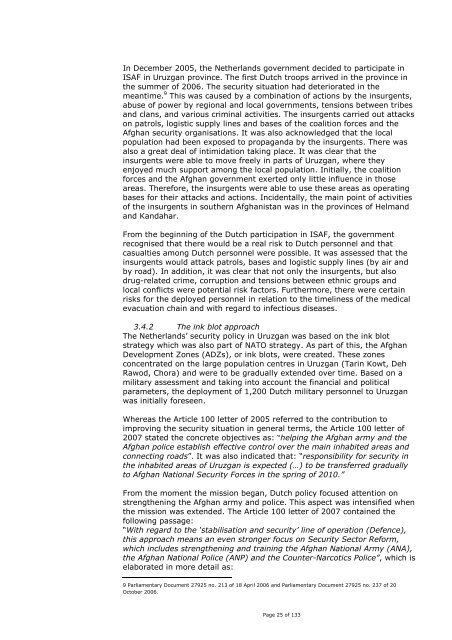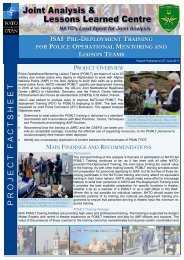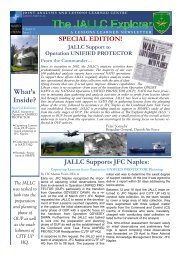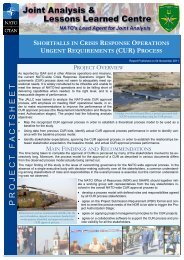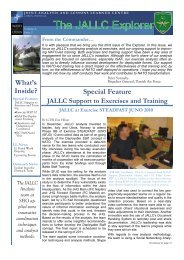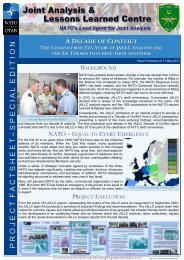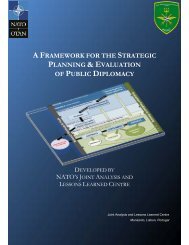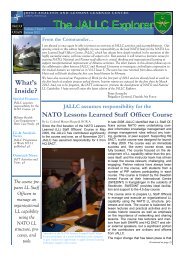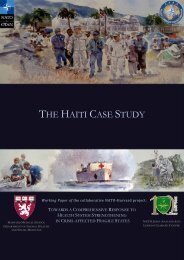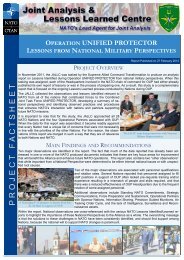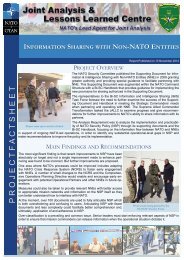Final evaluation Netherlands participation in ISAF 2006 - 2010
Final evaluation Netherlands participation in ISAF 2006 - 2010
Final evaluation Netherlands participation in ISAF 2006 - 2010
Create successful ePaper yourself
Turn your PDF publications into a flip-book with our unique Google optimized e-Paper software.
In December 2005, the <strong>Netherlands</strong> government decided to participate <strong>in</strong><strong>ISAF</strong> <strong>in</strong> Uruzgan prov<strong>in</strong>ce. The first Dutch troops arrived <strong>in</strong> the prov<strong>in</strong>ce <strong>in</strong>the summer of <strong>2006</strong>. The security situation had deteriorated <strong>in</strong> themeantime. 9 This was caused by a comb<strong>in</strong>ation of actions by the <strong>in</strong>surgents,abuse of power by regional and local governments, tensions between tribesand clans, and various crim<strong>in</strong>al activities. The <strong>in</strong>surgents carried out attackson patrols, logistic supply l<strong>in</strong>es and bases of the coalition forces and theAfghan security organisations. It was also acknowledged that the localpopulation had been exposed to propaganda by the <strong>in</strong>surgents. There wasalso a great deal of <strong>in</strong>timidation tak<strong>in</strong>g place. It was clear that the<strong>in</strong>surgents were able to move freely <strong>in</strong> parts of Uruzgan, where theyenjoyed much support among the local population. Initially, the coalitionforces and the Afghan government exerted only little <strong>in</strong>fluence <strong>in</strong> thoseareas. Therefore, the <strong>in</strong>surgents were able to use these areas as operat<strong>in</strong>gbases for their attacks and actions. Incidentally, the ma<strong>in</strong> po<strong>in</strong>t of activitiesof the <strong>in</strong>surgents <strong>in</strong> southern Afghanistan was <strong>in</strong> the prov<strong>in</strong>ces of Helmandand Kandahar.From the beg<strong>in</strong>n<strong>in</strong>g of the Dutch <strong>participation</strong> <strong>in</strong> <strong>ISAF</strong>, the governmentrecognised that there would be a real risk to Dutch personnel and thatcasualties among Dutch personnel were possible. It was assessed that the<strong>in</strong>surgents would attack patrols, bases and logistic supply l<strong>in</strong>es (by air andby road). In addition, it was clear that not only the <strong>in</strong>surgents, but alsodrug-related crime, corruption and tensions between ethnic groups andlocal conflicts were potential risk factors. Furthermore, there were certa<strong>in</strong>risks for the deployed personnel <strong>in</strong> relation to the timel<strong>in</strong>ess of the medicalevacuation cha<strong>in</strong> and with regard to <strong>in</strong>fectious diseases.3.4.2 The <strong>in</strong>k blot approachThe <strong>Netherlands</strong>’ security policy <strong>in</strong> Uruzgan was based on the <strong>in</strong>k blotstrategy which was also part of NATO strategy. As part of this, the AfghanDevelopment Zones (ADZs), or <strong>in</strong>k blots, were created. These zonesconcentrated on the large population centres <strong>in</strong> Uruzgan (Tar<strong>in</strong> Kowt, DehRawod, Chora) and were to be gradually extended over time. Based on amilitary assessment and tak<strong>in</strong>g <strong>in</strong>to account the f<strong>in</strong>ancial and politicalparameters, the deployment of 1,200 Dutch military personnel to Uruzganwas <strong>in</strong>itially foreseen.Whereas the Article 100 letter of 2005 referred to the contribution toimprov<strong>in</strong>g the security situation <strong>in</strong> general terms, the Article 100 letter of2007 stated the concrete objectives as: “help<strong>in</strong>g the Afghan army and theAfghan police establish effective control over the ma<strong>in</strong> <strong>in</strong>habited areas andconnect<strong>in</strong>g roads”. It was also <strong>in</strong>dicated that: “responsibility for security <strong>in</strong>the <strong>in</strong>habited areas of Uruzgan is expected (…) to be transferred graduallyto Afghan National Security Forces <strong>in</strong> the spr<strong>in</strong>g of <strong>2010</strong>.”From the moment the mission began, Dutch policy focused attention onstrengthen<strong>in</strong>g the Afghan army and police. This aspect was <strong>in</strong>tensified whenthe mission was extended. The Article 100 letter of 2007 conta<strong>in</strong>ed thefollow<strong>in</strong>g passage:“With regard to the ‘stabilisation and security’ l<strong>in</strong>e of operation (Defence),this approach means an even stronger focus on Security Sector Reform,which <strong>in</strong>cludes strengthen<strong>in</strong>g and tra<strong>in</strong><strong>in</strong>g the Afghan National Army (ANA),the Afghan National Police (ANP) and the Counter-Narcotics Police”, which iselaborated <strong>in</strong> more detail as:9 Parliamentary Document 27925 no. 213 of 18 April <strong>2006</strong> and Parliamentary Document 27925 no. 237 of 20October <strong>2006</strong>.Page 25 of 133


